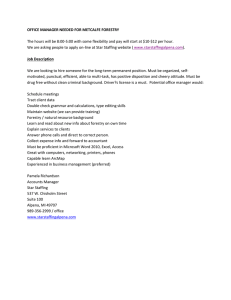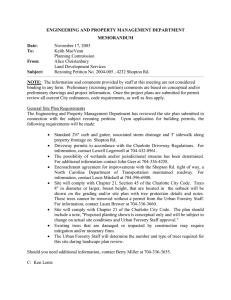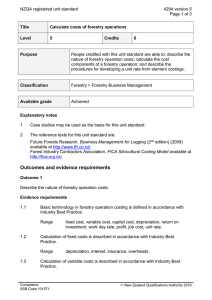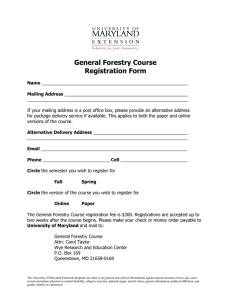NZQA registered unit standard 1247 version 8 Page 1 of 4
advertisement
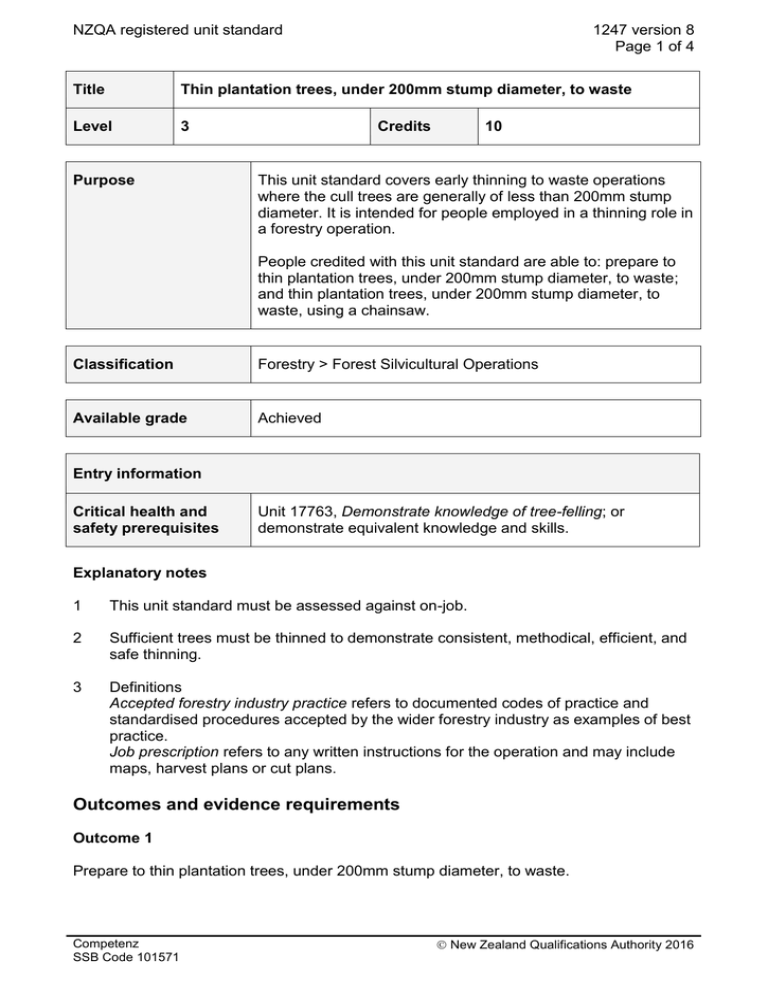
NZQA registered unit standard 1247 version 8 Page 1 of 4 Title Thin plantation trees, under 200mm stump diameter, to waste Level 3 Purpose Credits 10 This unit standard covers early thinning to waste operations where the cull trees are generally of less than 200mm stump diameter. It is intended for people employed in a thinning role in a forestry operation. People credited with this unit standard are able to: prepare to thin plantation trees, under 200mm stump diameter, to waste; and thin plantation trees, under 200mm stump diameter, to waste, using a chainsaw. Classification Forestry > Forest Silvicultural Operations Available grade Achieved Entry information Critical health and safety prerequisites Unit 17763, Demonstrate knowledge of tree-felling; or demonstrate equivalent knowledge and skills. Explanatory notes 1 This unit standard must be assessed against on-job. 2 Sufficient trees must be thinned to demonstrate consistent, methodical, efficient, and safe thinning. 3 Definitions Accepted forestry industry practice refers to documented codes of practice and standardised procedures accepted by the wider forestry industry as examples of best practice. Job prescription refers to any written instructions for the operation and may include maps, harvest plans or cut plans. Outcomes and evidence requirements Outcome 1 Prepare to thin plantation trees, under 200mm stump diameter, to waste. Competenz SSB Code 101571 New Zealand Qualifications Authority 2016 NZQA registered unit standard 1247 version 8 Page 2 of 4 Evidence requirements 1.1 Chainsaw and equipment are checked for suitability and safety in accordance with accepted forestry industry practice. Range 1.2 Job prescription requirements are identified and explained in terms of operational requirements. Range 1.3 includes – chainsaw safety features, chainsaw size, bar length, protective clothing and footwear, fuel and oil containers, first aid, high visibility clothing; may include – road signs, fire extinguisher. residual stocking, selection of cull trees, safety requirements, hazards, boundaries, environmental. Hazards are identified and managed to meet operational requirements in accordance with accepted forestry industry practice. Range may include but is not limited to – chainsaw use, terrain, ground conditions, falling trees, tree condition, other people, hang-ups, weather, fumes. 1.4 The reason for on-going hazard identification is explained in accordance with accepted forestry industry practice. 1.5 Factors that may change hazards or introduce new hazards are described in accordance with accepted forestry industry practice. Range 1.6 weather, terrain, hindrance. The requirements for a minimum number of workers in a thin to waste operation are explained in accordance with accepted forestry industry practice. Outcome 2 Thin plantation trees, under 200mm stump diameter, to waste, using a chainsaw. Evidence requirements 2.1 Cull trees are selected and assessed individually for hazards and felling direction in accordance with accepted forestry industry practice. Range branching, surrounding hindrance, potential for hang-ups. 2.2 Vegetation is cleared around trees, trees are limbed to allow access, and escape routes are prepared in accordance with accepted forestry industry practice. 2.3 Cull trees are felled in accordance with accepted forestry industry practice. Competenz SSB Code 101571 New Zealand Qualifications Authority 2016 NZQA registered unit standard 2.4 1247 version 8 Page 3 of 4 The requirements of the operation are met in accordance with the job prescription. Range stocking, spacing, trees cut from stump, environmental requirements, damage to residual crop. 2.5 Hang-ups are brought down in accordance with the accepted forestry industry practice. 2.6 Quality control is carried out on own work to ensure compliance with the job prescription. 2.7 Work method and work pattern suit the needs of the particular operation in accordance with accepted forestry industry practice, and meet job prescription requirements. Range techniques, equipment, ergonomics, use of terrain and contour, tree lean, wind, environmental requirements, other workers. Planned review date 31 December 2020 Status information and last date for assessment for superseded versions Process Version Date Last Date for Assessment Registration 1 28 January 1995 31 December 2012 Review 2 8 November 1996 31 December 2012 Revision 3 19 June 1998 31 December 2012 Review 4 5 December 2000 31 December 2012 Review 5 24 March 2003 31 December 2012 Review 6 22 May 2008 31 December 2012 Revision 7 16 July 2010 31 December 2016 Review 8 19 March 2015 N/A Consent and Moderation Requirements (CMR) reference 0173 This CMR can be accessed at http://www.nzqa.govt.nz/framework/search/index.do. Please note Providers must be granted consent to assess against standards (accredited) by NZQA, before they can report credits from assessment against unit standards or deliver courses of study leading to that assessment. Industry Training Organisations must be granted consent to assess against standards by NZQA before they can register credits from assessment against unit standards. Competenz SSB Code 101571 New Zealand Qualifications Authority 2016 NZQA registered unit standard 1247 version 8 Page 4 of 4 Providers and Industry Training Organisations, which have been granted consent and which are assessing against unit standards must engage with the moderation system that applies to those standards. Requirements for consent to assess and an outline of the moderation system that applies to this standard are outlined in the Consent and Moderation Requirements (CMR). The CMR also includes useful information about special requirements for organisations wishing to develop education and training programmes, such as minimum qualifications for tutors and assessors, and special resource requirements. Comments on this unit standard Please contact Competenz qualifications@competenz.org.nz if you wish to suggest changes to the content of this unit standard. Competenz SSB Code 101571 New Zealand Qualifications Authority 2016

